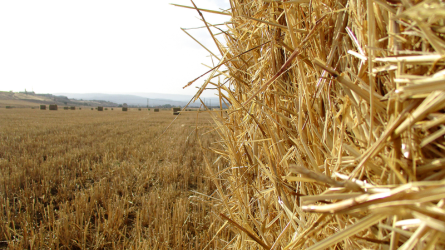Beyond the Bushel – How Grains Are Powering the Future of Sustainable Materials

Global Grain Perspectives is a continuing GEAPS series that explores grain uses across industries worldwide. Each article highlights a unique opportunity for grain processors and handlers, showcasing how corn, wheat, and sorghum are driving new demand beyond food, fuel, and feed.
In this article, we examine how grains are making their mark in sustainable packaging and industrial products such as compostable plastics and paper, adhesives, construction materials, and clothing. As industries look for greener alternatives to petroleum-based products, grain-derived materials are quietly gaining ground.
Starch to Shelf: Grains in Packaging
Grain-derived materials are already showing up in everyday products—many of which go unnoticed. Corn starch and wheat starch make biodegradable packaging peanuts, compostable plates and single-use containers. These starch-based products break down naturally, unlike traditional plastics, making them a favorite for eco-conscious consumers and companies.
Polylactic acid (PLA), a popular bioplastic made from corn, is used in everything from food packaging to clear cups. Companies like NatureWorks use corn sugar to produce PLA on a large scale in the Midwest, turning corn into a growing alternative to petroleum-based plastic. For grain handlers and processors, it’s a glimpse into a future where corn demand may come from packaging as well as ethanol.
Wheat straw—a byproduct often discarded or burned—is now being pulped into paper and molded into takeout containers, providing a tree-free and sustainable option for the paper industry. Not only does this create value from crop residue, it also helps reduce open-field burning and associated emissions.
Stick with Grain: Glues, Adhesives, and Coatings
Most corrugated boxes in North America stick together with starch-based adhesives made from corn or wheat. These natural glues are strong, affordable and recyclable—offering a better environmental profile than synthetic adhesives. For the packaging industry, grain starch isn’t a novelty—it’s the norm.
Grain-based adhesives also show up in paper bags, envelopes, and labeling. The exploration continues for corn and wheat proteins, such as zein and gluten, for bio-based coatings and food-safe finishes. These materials offer a natural alternative to petroleum waxes or plastic coatings used in food packaging, tablets, and produce.
Building with Grain: From Fields to Fiberboard
Beyond packaging, grains are being used in the construction industry. Wheat straw and other crop residues are now being turned into strawboard—a renewable alternative to particleboard or MDF. These boards are free from formaldehyde and can match the strength of wood-based materials, making them ideal for furniture and interior construction.
Ford made headlines when it used wheat straw fiber in plastic parts for its vehicles. The initiative reduced weight, cut costs and gave farmers a new outlet for surplus straw. More broadly, grain byproducts are being blended into composite materials used in everything from furniture to decking.
This is part of a larger trend in manufacturing: replacing synthetic materials with renewable, plant-based alternatives. For grain processors, it opens the door to working with industries well outside the traditional food and fuel space.
From Corn to Chemicals: Bioplastics and Bio-Based Ingredients
Grains—especially corn—are now feedstocks for a wide range of bio-based chemicals used in plastics, fabrics and cleaning products. Fermented corn sugar produces lactic acid, butanediol, and other building blocks for biodegradable plastics and fibers through processing.
Companies like Cargill and DuPont have invested heavily in corn-based materials. One product, Sorona®, uses corn sugar to produce a partially bio-based polyester fiber found in carpets, athletic wear, and outerwear. The result is a high-performance material with a reduced environmental footprint.
Projects like these give corn a new identity as a raw material for everything from stretch fabrics to paper cup linings—expanding the role of grain in the circular economy for these types of sustainable materials.
Sorghum’s Quiet Strength
While corn and wheat lead the way, sorghum is also gaining attention. Its grain and stalks contain valuable starch, protein, and wax with potential for biodegradable coatings, packaging, or edible utensils. Its drought resilience makes it attractive as a sustainable feedstock, especially in areas with limited water.
Researchers and startup companies are exploring how to turn sorghum into everything from compostable films to molded tableware. These innovations help position sorghum as more than just a feed and ethanol crop—it’s becoming part of the bio-based future of sustainable materials.
The Opportunity for Grain Handlers
What does this all mean for grain producers and handlers?
It means that demand for grain is growing in new directions. Corn, wheat, and sorghum have processing potential in materials that end up in grocery store packaging, car interiors, apparel, and building materials. These uses often pay a premium, and they align with broader sustainability goals that industries—and consumers—are demanding.
There’s also increasing investment in rural biomanufacturing—plants that turn grain into bio-based chemicals or packaging materials. These facilities create jobs, add value to local crops, and use existing grain infrastructure in new ways.
Looking Ahead
Grain isn’t just food or fuel anymore—it’s fast becoming the raw material of the sustainable economy. From biodegradable plastics and adhesives to construction panels and textiles, corn, wheat, and sorghum are powering the shift toward greener products and packaging.
For grain professionals, this is more than a trend. It’s a chance to diversify markets, partner with new industries and strengthen the long-term value of grain. As demand grows for renewable, sustainable materials, grain will be at the heart of the solution.
Stay tuned for the next Global Grain Perspectives article, where we’ll continue exploring how grain powers innovation around the world.


